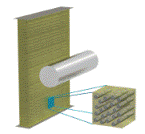Mechanical and Materials Engineering, Department of

Department of Engineering Mechanics: Dissertations, Theses, and Student Research
Date of this Version
Fall 12-15-2009
Document Type
Dissertation
Abstract
There is a high degree of interest in organic thin films for lightweight, low power, rugged and flexible electronics. Conjugated organic molecules with polycyclic rings are being considered a major enabler of such applications. Due to a surface tension mismatch between the organic molecule with the inorganic support (mainly silicon oxides), molecular packing inside these thin films is often disordered, which suppresses the device performance. There are major efforts focused on modifying the bulk properties, for instance, maximizing orbital overlaps in the solid state, little attention was paid to receive long-range ordered thin films. A novel approach to afford conjugated molecules self-organization capability is reported in this dissertation.
The objectives of this dissertation are to: 1) combine a conjugated ring system with an organosilane moiety to compose a bifunctional molecule; 2) investigate the self-assembling of this molecule; and 3) establish a robust theoretical model to understand the assembling process and structure of packed films. Several important progresses have been made. First, the assembly process of aromatic silanes is investigated, in contrast to mostly studied alkylsilanes. These molecules could form organized, bilayer-by-bilayer nanolayers. Compared to regular alkyl-based nanolayers, these aromatic nanolayers show much enhanced thermal properties due to the dipole-dipole interactions between individual layers. By using Ultraviolet Photoemission Spectroscopy (UPS), significant π-π interactions between the molecules were found. Following that, anthracene was used as an electronic component for the conjugated silane. These molecules formed a polymeric 1D backbone after self-assembly. Hydrophobic branches, plus a noncovalent π-π binding between the 1D chains, further promoted the formation of a freestanding nanolayer.


Comments
A dissertation Presented to the Faculty of The Graduate College at the University of Nebraska In Partial Fulfillment of Requirements For the Degree of Doctor of Philosophy, Major: Engineering (Materials Engineering). Under the Supervision of Professor Li Tan
Lincoln, Nebraska: December, 2009
Copyright (c) 2009 Ocelio V. Lima